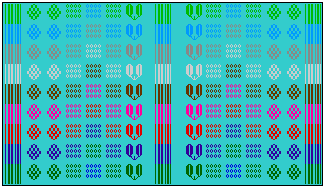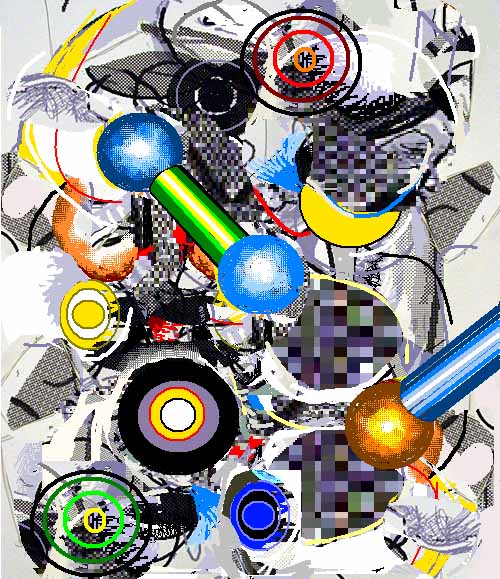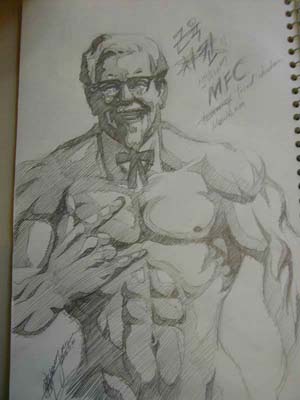View current page
...more recent posts
Paul Slocum announces the completion of the first release version of his Cynthcart, a program that turns the vintage Commodore 64 computer into a synthesizer (with a piano keyboard overlay covering your QWERTY keyboard). The cartridge, which also generates lo-fi psychedelic graphics, is available for purchase at the Atariage store.
The music made with the Cynthcart sounds great from the .mp3s; the SID chip's characteristic nasal sawtooth sound is unmistakable, and I like the third track, where Slocum has spliced it with scrambled vocal bits--also the fourth, which is a full blown song with rhythm programming. I know the chip a bit from working with Elektron's Sidstation synth, and yes, I'm a consumerist techphobic weenie for using a current piece of hardware instead of a killer mod of the original gear, but (this promises to be a constant theme today) I'm only abstractly interested in what's under the hood. I've learned a lot about softsynths this year and am increasingly drawn to big, user-friendly graphic interfaces where I can control sound visually.
Speaking of the SID and Sidstation, others doing good things with them are MEQ AND THE URS ("this page is no longer supported in Internet Explorer below version 7 and if you're still using IE you probably won't like this music anyway"--right, Jotsif, or because someone is surfing at work and doesn't have a choice, thanks for condescending to about half your potential listeners) and Receptors, which was one of my favorite acts at the last BENT (circuit bending) festival at the Tank in NY--still haven't posted my pic of him. Someone really ought to do some curating/compiling of the current SID music that's out there. With critical commentary! Dream on. The chatboards mostly talk about the gear, never composing music.
Jack Masters has a funny cartoon up on his page caricaturing the main Internet search engines. Yahoo! consists of signposts pointing in a dozen directions, Jeeves is servile but basically mentally defective, etc. The cartoon leads into a pro-Google, or rather anti-anti-Google rant by Masters that I've definitely been on the other side of. Yes, if Google starts to suck we'll stop using it and then we won't have to worry about it being all-powerful, and if separation of powers starts to slip we'll elect a more aggressive Congress that will stand up to the President. A few weeks back Masters posted a gnarly piece of electro-noise music that I really like. I sampled a couple of snippets from it for my song "Unfriendly Satellites," which I recently realized lacks a bass line and needs one rather badly--working on it. Regarding the Masters piece, can someone please explain the following exchange about it in his comments? I'm curious and baffled:
earthbound called, it wants its background music back
# posted by applesos : 6:29 PM
i thought earthbound's background music was like... a choir... i only have one song from it
# posted by Jack Masters : 5:07 PM


Via Travis Hallenbeck, African textiles using a programming language called Logo, specifically the GS LogoWriter on an Apple IIGS computer. The page linked to, a text written 12 years ago, goes into great technical detail as to how the patterns were created. I was not previously familiar with Logo or even that generation of Apples; it looks like another language-cum-family of gear (like Amiga, NES, etc) with a philosophy and a cult behind it. Obviously I'm spewing hot air here, being more interested in the beautiful finished product than how anyone arrived at it. But see What is Logo? if you're as un-up-to-speed as I am and want to know more.

"Robollywood" [4 MB .mp3]
"Darken Room, Eat Pills" [mp3 removed]
Both pieces use samples from NI's "simple waveform kit," hence the videogamy bleeps, as well as MIDI files intended for drum kits, run through synths as lead instruments. Fans of super-fast nerdy contrapuntal prog-rockish keyboard playing might like "Robollywood"--I'm constantly surprised how well percussion scores translate into tonal playing, with adult supervision in the form of splicing and muting notes.

artist unknown
My essay on painter Kara Hammond appears here, along with some images of her work (link at upper right), a couple of which were previously shown on this blog. The occasion for the writing is her show at the Halsey Gallery, College of Charleston, South Carolina, the school where she is now teaching.
Below are three views of Werner Herzog's great film Grizzly Man. All are interesting, though Ross Douthat's piece is a tad over-the top in its religious references. The writers should give Herzog more credit for the film's intellectual and emotional heft, though; if it makes sense to talk about religion at all it's because of the layer of profundity his commentary and editing bring to the found material, even though, pardon the further and possibly contradictory qualifier, his interest in intense, ecstatic states seems purely secular. Lindsay Beyerstein nails how the narcissism of doomed ursine documentarian Timothy Treadwell tainted his own mission, but Herzog sees magic in Treadwell's camera artistry, actor-like temperament, and willingness to go "out there" to the furthest edges of experience. David Edelstein notes Herzog's contributions but thinks they're melodramatic, and of course they are, it's Herzog, but their success in steering how we view Treadwell's footage is none the less awe-inspiring. Also in response to Berenstain, I mean, Beyerstein, Treadwell's knowledge of the bears isn't really "shallow"--he's constantly dropping factoids in the film about how they mate, fight, hibernate, kill their young... Maybe this information is wrong, but he clearly learned enough to live with them at close quarters for thirteen summers before they finally did him in.
Ross Douthat:
Grizzly Man is a film about religious experience, among many other things, but not a form of religious experience that's familiar to most people in the still-Christ-haunted West. Human beings are caught between the animal world and the spiritual world, bound by fleshly requirements, but able to imagine themselves as immortal, freed from bodily concerns, quasi-divine - and in response to this problem, Christianity (and most other mainstream faiths) tells people that the way out is up, and that to escape the conflicts and miseries that come with being half angel and half ape, you need to become more like an angel, and less like an ape.Lindsay Beyerstein:
But the imitatio Dei isn't the only possible solution to the dilemma of being made a little lower than the angels. You could also go in the other direction, and give up on human reason, human self-awareness, in the hopes of returning to a pre-rational, pre-spiritual, entirely animal state. This kind of radical return to Nature - which is very different from, say, a Thoreauvian "going to the woods," in which the goal is contemplation, not participation - can be found in some pagan traditions, in aspects of Native American totemism and in some of the stranger cults of ancient Greece. The Secret History, Donna Tartt's great novel, is about the pursuit of just this kind of back-to-Nature religious experience. And so is Grizzly Man.
But Nature won't take us back.
More than anything Grizzly Man captures the paradox of narcissism. Treadwell can't relate to anyone or anything except as an extension of his own desires. He desperately wants to be liked and respected, but he can't step outside himself long enough to imagine how he's coming across to other people, or to animals, for that matter.David Edelstein:
Herzog and his informants search for meaning in Treadwell's life and death. What did he really accomplish? Very little, as it turns out. He didn't learn much about bears because he was overcome by his own gooey sentimentality. He didn't learn anything about himself. You keep wondering when he's going to realize how absurd he looks. Instead, he spent his months of solitude constructing elaborate cinematic "proof" of his own heroism. Ironically, the record shows the exact opposite.
Grizzly Man has the tang of the famous chapter in Moby Dick, Melville's sardonic answer to the Transcendentalist movement, which produced Thoreau (and Whitman). You might sit astride a mast and feel your oneness with nature, Melville wrote, but fall into the sea and you're going to get eaten. For all his attention to his bears, for all his boasts that he was "on the precipice of death" and could be attacked at any moment, Treadwell didn't fully see nature. Reinventing himself after years as a down-and-out alcoholic, he clearly turned the bears into his version of the "higher power" fervently embraced by members of Alcoholics Anonymous.
Was Treadwell suicidal? He often said that his life and cause might be looked at more seriously if he died in the wilderness, although the bear that ate him and his girlfriend was riddled with bullets by rangers before Treadwell had even been digested, and the chief lesson to draw from his story is to do the exact opposite of what he did--to keep one's distance from these huge predators. Parts of Grizzly Man are as bone-chilling as The Blair Witch Project—especially the footage from Treadwell's final days. After railing at humankind (was he bipolar?) and an altercation with an "obese" airport gate agent (what was that about?), he and his girlfriend returned to the maze at a time of year when most of the more tolerant bears were hibernating, and only the old and desperate-for-food ones remained.
